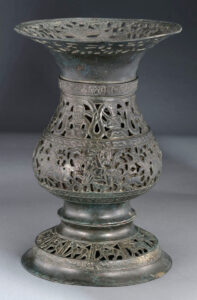
LNS 1052 M a,b
Reticulated bronze lamp, with: mounted riders hunting with felines and falcons; representations of the twelve signs of the zodiac and the seven planets, all identified
The al-Sabah Collection contains almost two thousand items of metalwork ranging from elaborately worked vessels inlaid with precious metals to simply cast bronze finials in the form of animals. Islamic metalworkers, whether in Cairo or Herat, often fashioned relatively simple forms covered the surface in dazzling engraved or precious metal-inlaid patterns of arabesque interlace, processions of animals or long benedictory inscriptions. Objects with calligraphy as decoration occur more frequently in metalwork than any other medium used for objects of utility. These range from benedictory inscriptions to verses from the Qur’an to lines of poetry, and sometimes include the signatures of the artists.
The ancient Near East has a long history of working in copper alloy and bronzes and brasses (copper alloyed with other metals) became the most important material in the pre-Islamic periods. Objects are almost invariably sculpturally powerful. In the hands of skilled artists, everyday objects such as oil lamps or incense burners became works of art. Brass was especially popular in the Mamluk domains. In the later period, especially in Iran and India, steel was used for decorative purposes; despite its hardness, it could be cut in openwork patterns, such as arabesques and calligraphic compositions as delicate as lace.

Reticulated bronze lamp, with: mounted riders hunting with felines and falcons; representations of the twelve signs of the zodiac and the seven planets, all identified
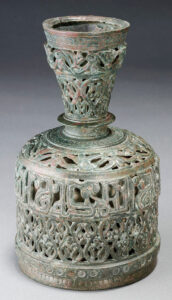
Reticulated double-walled bronze bottle with bands of undulating half-palmette scrolls, and a prominent band with good wishes to the owner in Kufic script

Bronze incense burner (lid missing) decorated in openwork with scrolling vines, and with handle finial in the form of a poppy fruit

Brass planispheric astrolabe (the earliest known Islamic example), signed by Muhammad ibn ‘Abdallah (known as ‘Nastulus’) and dated in Arabic letters (abjad numeration) to 315

Bronze ewer with spirally ribbed body, one rib with a single diminutive scroll. The handle’s ‘thumbrest’ in the form of a palmette, its base terminated
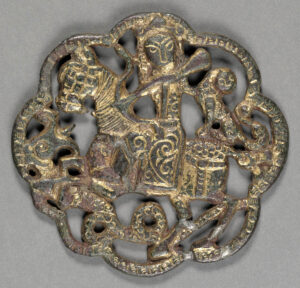
Gilded bronze belt or harness fitting with representation in openwork of a mounted bowman about to shoot a serpentine-bodied dragon, with a cheetah perching on
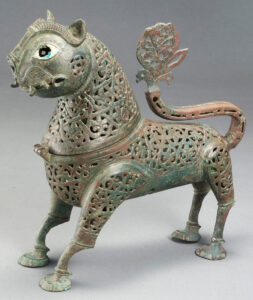
Bronze incense burner in the form of a stylized feline, cast in intricate openwork to release the incense, with inlaid faience and glass eye, the
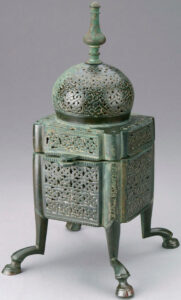
Bronze incense burner, the openwork body and lid suggesting a domed building, the feet those of a quadruped; inscribed in Kufic script, ‘Blessing to Abi
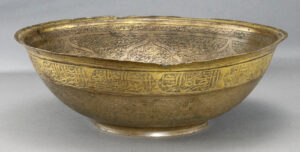
Parcel gilt bronze divining bowl (central post and rotational element lost), the interior with stellate layout; covered with inscriptions, including passages from the Qur’an, invocations
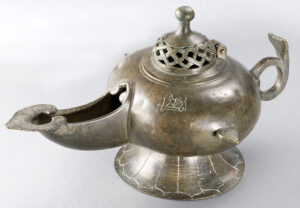
Bronze oil lamp with domical lid featuring an openwork plait design, a leaf-shaped spout, and a Kufic inscription wishing ‘Blessing and happiness’ to its owner
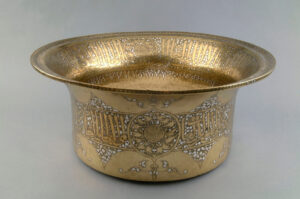
Brass basin inlaid with silver featuring thuluth inscriptions lauding an (unnamed) officer of al-Malik an-Nasir Muhammad ibn Qala’un (r. 693-741 AH/1293-1341 AD, with interruptions), ogives
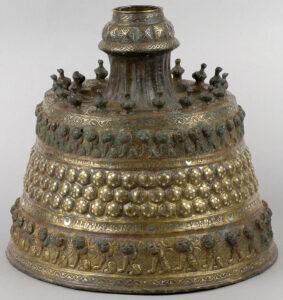
Bronze candlestick inlaid with copper and silver, with salient rows of ducks and seated lions, and invocations of good wishes to the owner in Kufic

Combined silver folding spoon and fork inlaid with niello, with pious inscriptions in Kufic invoking God, and with vegetal arabesques and representations of simurghs and
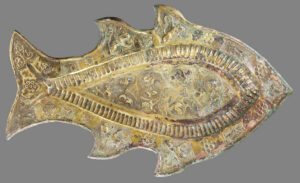
Bronze dish in the form of a fish (for the serving of fish?), decorated with winged lions, hares, seven-circle rosettes, flutes and a vegetal arabesque
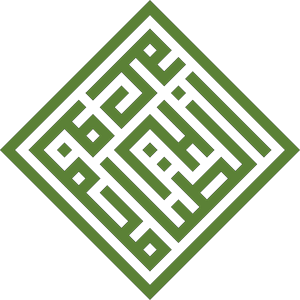
About Us
Archive
Collection
Publications
Subscribe to news about Dar al-Athar al-Islamiyyah and The al-Sabah Collection, Exhibitions, Courses and Events
Subscribe to news about Dar al-Athar al-Islamiyyah and The al-Sabah Collection, Exhibitions, Courses and Events